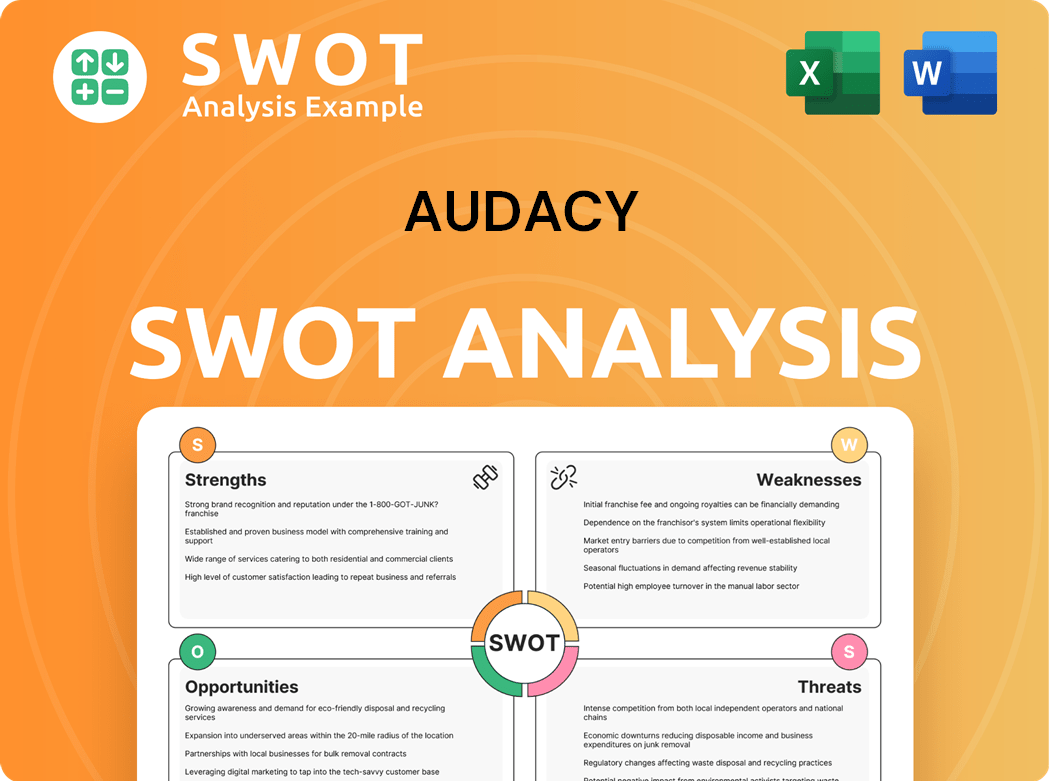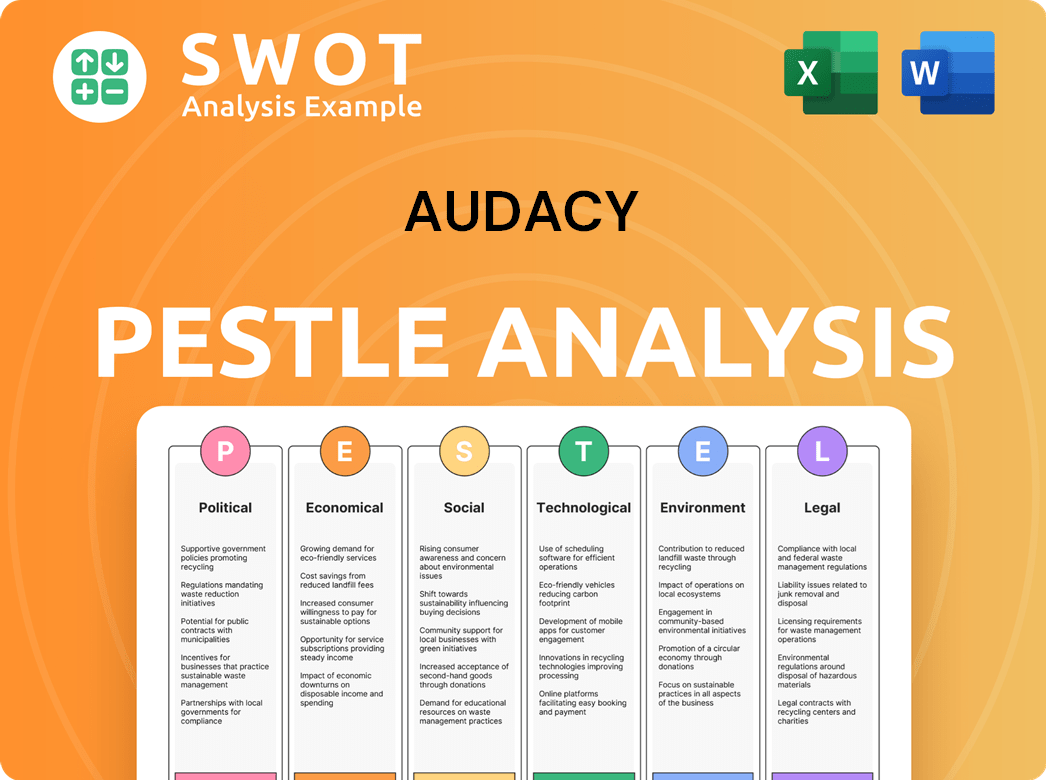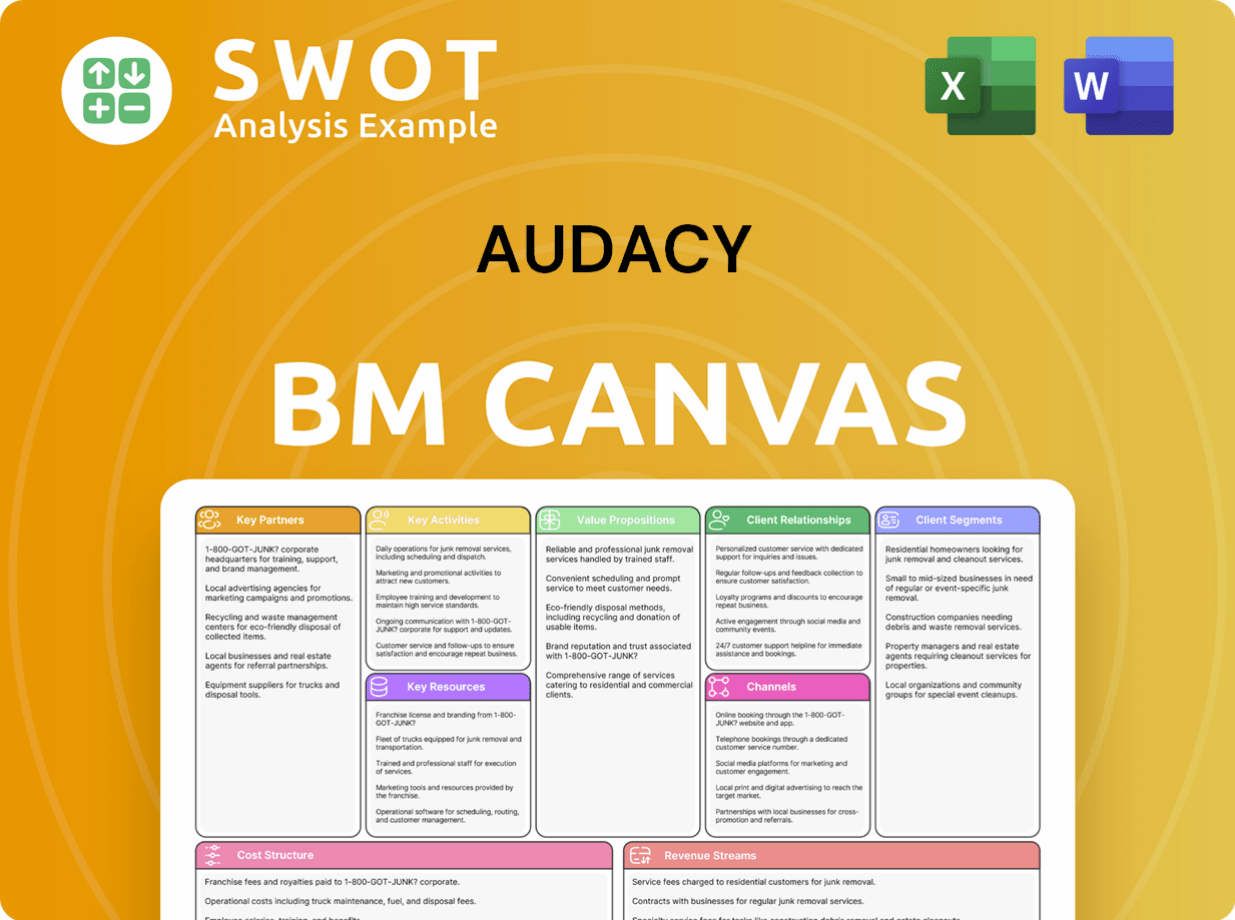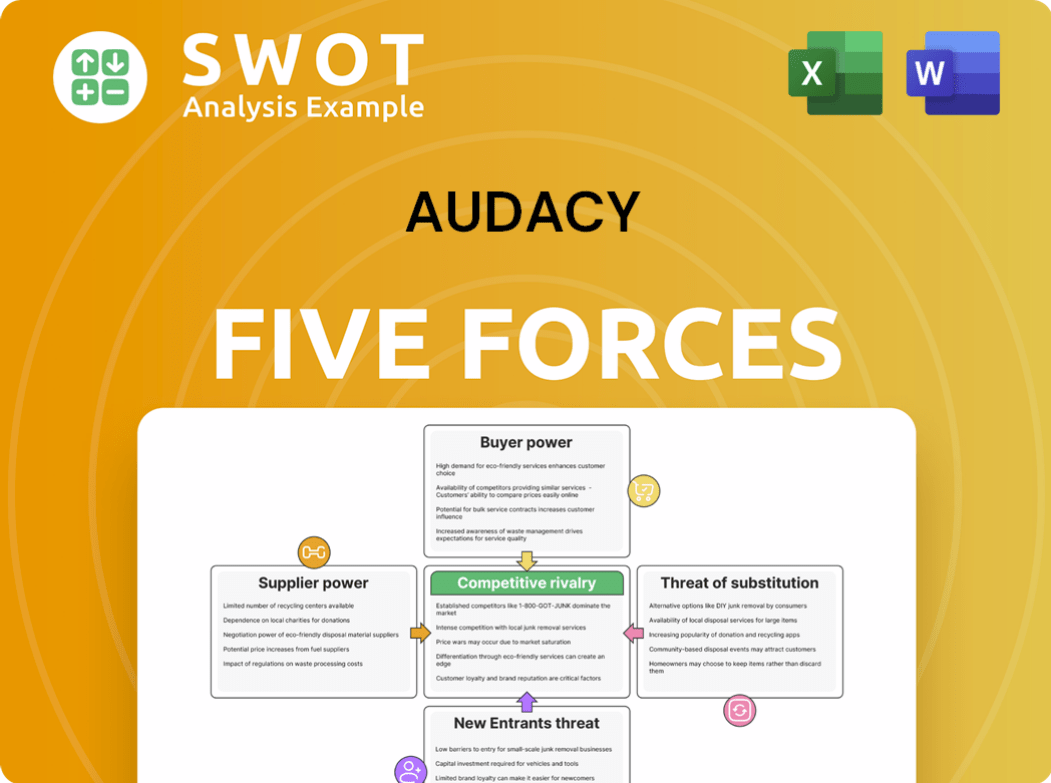Audacy Bundle
Can Audacy Thrive in Today's Media Jungle?
In an era where digital platforms reign supreme, how does a traditional media giant like Audacy, Inc. navigate the evolving landscape? Founded in 1968, Audacy has transformed from a regional radio operator to a major player in the audio entertainment industry. This journey, marked by strategic acquisitions and a growing digital presence, sets the stage for a deep dive into its competitive positioning.

Understanding the Audacy SWOT Analysis is crucial for grasping its position within the radio industry and beyond. This media company faces intense competition, making a thorough Audacy market analysis essential. Examining Audacy's competitive landscape and identifying its key Audacy competitors reveals the challenges and opportunities shaping its future. Analyzing the Audacy business model will also provide insights into its strategies for audience engagement and revenue generation.
Where Does Audacy’ Stand in the Current Market?
The Audacy competitive landscape is primarily defined by its position within the U.S. audio industry, specifically in broadcast radio. As of early 2024, the company is a significant player, ranking among the largest radio broadcasters by both revenue and audience reach. Its core operations revolve around terrestrial radio broadcasting, digital audio streaming, and a growing podcast network, alongside digital marketing and advertising solutions.
Audacy's value proposition centers on providing a wide array of audio content to a vast audience across multiple platforms. This includes live radio broadcasts, on-demand streaming through the Audacy app, and a diverse podcast library. The company also offers comprehensive advertising solutions, leveraging its extensive reach and audience data to help businesses connect with their target markets. The Audacy business model is built on generating revenue through advertising sales, content licensing, and digital subscriptions.
Geographically, Audacy's presence is concentrated in key U.S. metropolitan areas, where it often holds leading market shares in specific formats. The company has been strategically shifting its focus towards digital transformation to complement its traditional broadcast assets, including investments in its Audacy app. Financially, the company reported net revenues of $283.4 million for the fourth quarter of 2023, a decrease compared to the prior year.
Audacy operates over 200 radio stations across 47 major markets in the U.S. This extensive network allows the company to reach an estimated 170 million listeners monthly. The company’s scale is significant compared to many smaller regional broadcasters, allowing for economies of scale in content creation and advertising sales.
The company's digital strategy focuses on expanding its digital audio offerings to capture a larger share of the digital audio market. This includes the Audacy app, which aggregates live station streams, podcasts, and exclusive digital content. Recent initiatives include investments in digital content creation and distribution to enhance user engagement.
Audacy has been navigating a challenging advertising market. The company reported net revenues of $283.4 million for the fourth quarter of 2023. The radio industry is facing challenges, but Audacy's size and diverse content portfolio help it to maintain a competitive position.
Audacy maintains a strong position in sports audio content. It has a robust portfolio of local and national sports talk stations and partnerships. This focus on sports content provides a competitive advantage in attracting and retaining listeners, particularly in key markets.
The Audacy market analysis reveals that the company faces both opportunities and challenges. The shift towards digital audio consumption and the evolving advertising landscape are key factors influencing its performance. Owners & Shareholders of Audacy need to understand these dynamics.
- Audacy's strengths and weaknesses analysis highlights its extensive reach and diverse content portfolio as strengths.
- Audacy's competitive advantages in the radio market include its strong presence in key metropolitan areas and its focus on sports content.
- Audacy's challenges in the media industry include navigating a competitive advertising market and adapting to changing consumer preferences.
- Audacy's future outlook and growth potential depend on its ability to successfully execute its digital strategy and maintain its audience engagement.
Audacy SWOT Analysis
- Complete SWOT Breakdown
- Fully Customizable
- Editable in Excel & Word
- Professional Formatting
- Investor-Ready Format

Who Are the Main Competitors Challenging Audacy?
The Audacy competitive landscape is complex, encompassing both traditional and digital media. Understanding Audacy's competitors is crucial for analyzing its market position and future prospects. The company faces challenges from established players in the radio industry and emerging digital platforms.
Audacy's market analysis reveals a dynamic environment where audience preferences and advertising spending are constantly evolving. This article will delve into the key competitors shaping Audacy's business and the strategies it employs to maintain its competitive edge. The analysis will consider both direct and indirect competitors, offering a comprehensive view of the challenges and opportunities Audacy faces.
As a media company, Audacy's success hinges on its ability to attract listeners and advertisers. The Audacy business model is heavily reliant on advertising revenue, which is influenced by the company's ability to compete effectively in a crowded market. The competitive landscape is constantly shifting due to technological advancements and changing consumer habits.
iHeartMedia is a major direct competitor, operating a vast network of radio stations across the United States. Cumulus Media also competes directly with Audacy, particularly in local markets, offering similar content and advertising opportunities. These companies compete on local programming, talent, and market-specific advertising sales.
Spotify and Apple Music dominate the music streaming market, attracting listeners away from traditional radio. SiriusXM offers satellite radio and streaming services with exclusive content, competing for both listeners and advertising revenue. Podcasts, including those from Amazon-owned Wondery and The Daily Wire, also compete for audience attention.
Television, social media platforms like Meta and TikTok, and digital advertising giants such as Google and Meta indirectly compete for advertising budgets. Emerging digital-first and niche-focused audio content creators also pose a threat by capturing specific audience segments.
The competitive landscape is significantly influenced by potential mergers and acquisitions. These events can reshape market leadership and introduce new competitive pressures. The radio industry is subject to consolidation, which can impact the competitive balance.
Audacy must continually adapt its strategies to stay competitive. This includes focusing on digital audio, podcasting, and innovative content creation. Understanding Audacy's strengths and weaknesses analysis is essential for formulating effective strategies.
The radio industry faces challenges in advertising revenue due to competition from digital platforms. Audacy's ability to maintain and grow its advertising revenue is critical for its financial performance. Understanding Audacy's advertising revenue trends is vital.
Audacy's competitive advantages include its established radio station portfolio and local market presence. However, it faces challenges such as declining listenership in traditional radio and intense competition from digital platforms. For a deeper dive, consider the Marketing Strategy of Audacy.
- Audacy's radio station portfolio provides a significant reach across various markets.
- Digital audio and podcasting are key areas for growth, allowing Audacy to compete more effectively.
- The company must navigate the evolving media landscape and adapt to changing consumer behaviors.
- Audacy's geographic market presence influences its ability to compete effectively in local markets.
Audacy PESTLE Analysis
- Covers All 6 PESTLE Categories
- No Research Needed – Save Hours of Work
- Built by Experts, Trusted by Consultants
- Instant Download, Ready to Use
- 100% Editable, Fully Customizable

What Gives Audacy a Competitive Edge Over Its Rivals?
Understanding the Audacy competitive landscape involves assessing its strengths, weaknesses, and strategic positioning within the dynamic radio and digital audio industry. The company navigates a complex market, facing established rivals and emerging digital platforms. A thorough Audacy market analysis reveals how the company leverages its assets to compete effectively.
Audacy's strategy focuses on a hybrid model, combining its extensive broadcast reach with a growing digital presence. This approach allows it to cater to both traditional radio listeners and the increasing number of consumers who prefer on-demand audio content. The company's ability to adapt and innovate is critical for sustaining its competitive edge.
Analyzing Audacy's competitive advantages provides insights into its ability to maintain and grow its market share. The company's success depends on its ability to attract and retain listeners, secure advertising revenue, and effectively compete with both traditional and digital media companies. A key aspect of its strategy is to leverage its local market expertise and content offerings.
Audacy operates over 200 radio stations across 47 U.S. markets, providing a significant local presence. This extensive reach allows for strong connections with local communities. The broad geographic coverage is a key differentiator in the radio industry.
The company offers a wide array of content, including news, sports, and entertainment, catering to diverse listener preferences. It has exclusive broadcast rights for numerous professional and collegiate sports teams. This content diversity helps to attract and retain a broad audience base.
Audacy's digital platform and app aggregate its broadcast content, podcasts, and exclusive digital audio. This unified digital experience extends its reach beyond traditional radio. The digital focus is crucial for competing in the on-demand audio market.
Many of Audacy's radio stations have decades of history and established listener bases. This brand equity provides a competitive advantage in local markets. Strong brand recognition helps to build listener loyalty and attract advertisers.
Audacy's competitive advantages are rooted in its extensive broadcast network, diverse content offerings, and strategic digital initiatives. These factors collectively contribute to its ability to attract listeners and advertisers. The company's ability to adapt to the changing media landscape is critical for its long-term success.
- Extensive Local Presence: Operating over 200 radio stations provides a significant advantage in local markets.
- Digital Platform: The Audacy app and digital platform extend reach beyond traditional radio.
- Content Diversity: A wide range of content, including sports, news, and entertainment, attracts a broad audience.
- Advertising Solutions: Robust advertising solutions leverage audience data and cross-platform capabilities.
For a deeper dive into the company's growth strategy, consider reading the Growth Strategy of Audacy. This analysis provides additional context regarding Audacy's market position and future prospects within the competitive audio landscape. Understanding Audacy's strengths and weaknesses is essential for a comprehensive Audacy market analysis.
Audacy Business Model Canvas
- Complete 9-Block Business Model Canvas
- Effortlessly Communicate Your Business Strategy
- Investor-Ready BMC Format
- 100% Editable and Customizable
- Clear and Structured Layout

What Industry Trends Are Reshaping Audacy’s Competitive Landscape?
The Audacy competitive landscape is significantly shaped by evolving industry trends, including the shift from traditional radio to digital audio platforms. This transformation presents both risks and opportunities for the media company, impacting its Audacy business model and requiring strategic adaptation. Understanding these dynamics is crucial for evaluating Audacy's future outlook and growth potential.
Audacy's market analysis reveals a complex environment. The company faces challenges such as declining terrestrial radio advertising revenue and increased competition. However, the rise of digital audio and podcasting provides avenues for growth, requiring innovative content strategies and effective monetization of its assets. For more details, explore the Growth Strategy of Audacy.
The radio industry is experiencing a decline in traditional advertising revenue, with a shift towards digital audio platforms. Smartphone penetration and improved internet access are accelerating this trend. Regulatory changes and the impact of AI in content creation also influence the market.
Audacy's challenges in the media industry include declining radio advertising revenue and increased competition from tech giants. Fragmentation of listener attention across various platforms poses a significant threat. Maintaining human-centric content and advertising sales in the face of AI is another hurdle.
The growing popularity of podcasts and spoken-word content offers opportunities for expansion. Investments in data analytics and programmatic advertising can enhance digital marketing solutions. Strategic partnerships can unlock new revenue streams and expand reach.
Accelerating digital transformation, innovating content offerings, and effectively monetizing diverse audio assets are essential. Focusing on audience engagement and adapting to the evolving media landscape will be critical for Audacy's competitive advantages in the radio market.
Audacy's market share 2024 is influenced by its ability to adapt to digital trends and compete with major players like iHeartMedia. Audacy's competitors include streaming services and other media companies. Strategic decisions will determine its financial performance compared to competitors.
- Focus on digital audio and podcasting to attract new audiences.
- Invest in data analytics and programmatic advertising for enhanced marketing solutions.
- Form strategic partnerships to expand reach and unlock new revenue streams.
- Adapt to changes in advertising revenue trends and content consumption.
Audacy Porter's Five Forces Analysis
- Covers All 5 Competitive Forces in Detail
- Structured for Consultants, Students, and Founders
- 100% Editable in Microsoft Word & Excel
- Instant Digital Download – Use Immediately
- Compatible with Mac & PC – Fully Unlocked

Related Blogs
- What are Mission Vision & Core Values of Audacy Company?
- What is Growth Strategy and Future Prospects of Audacy Company?
- How Does Audacy Company Work?
- What is Sales and Marketing Strategy of Audacy Company?
- What is Brief History of Audacy Company?
- Who Owns Audacy Company?
- What is Customer Demographics and Target Market of Audacy Company?
Disclaimer
All information, articles, and product details provided on this website are for general informational and educational purposes only. We do not claim any ownership over, nor do we intend to infringe upon, any trademarks, copyrights, logos, brand names, or other intellectual property mentioned or depicted on this site. Such intellectual property remains the property of its respective owners, and any references here are made solely for identification or informational purposes, without implying any affiliation, endorsement, or partnership.
We make no representations or warranties, express or implied, regarding the accuracy, completeness, or suitability of any content or products presented. Nothing on this website should be construed as legal, tax, investment, financial, medical, or other professional advice. In addition, no part of this site—including articles or product references—constitutes a solicitation, recommendation, endorsement, advertisement, or offer to buy or sell any securities, franchises, or other financial instruments, particularly in jurisdictions where such activity would be unlawful.
All content is of a general nature and may not address the specific circumstances of any individual or entity. It is not a substitute for professional advice or services. Any actions you take based on the information provided here are strictly at your own risk. You accept full responsibility for any decisions or outcomes arising from your use of this website and agree to release us from any liability in connection with your use of, or reliance upon, the content or products found herein.